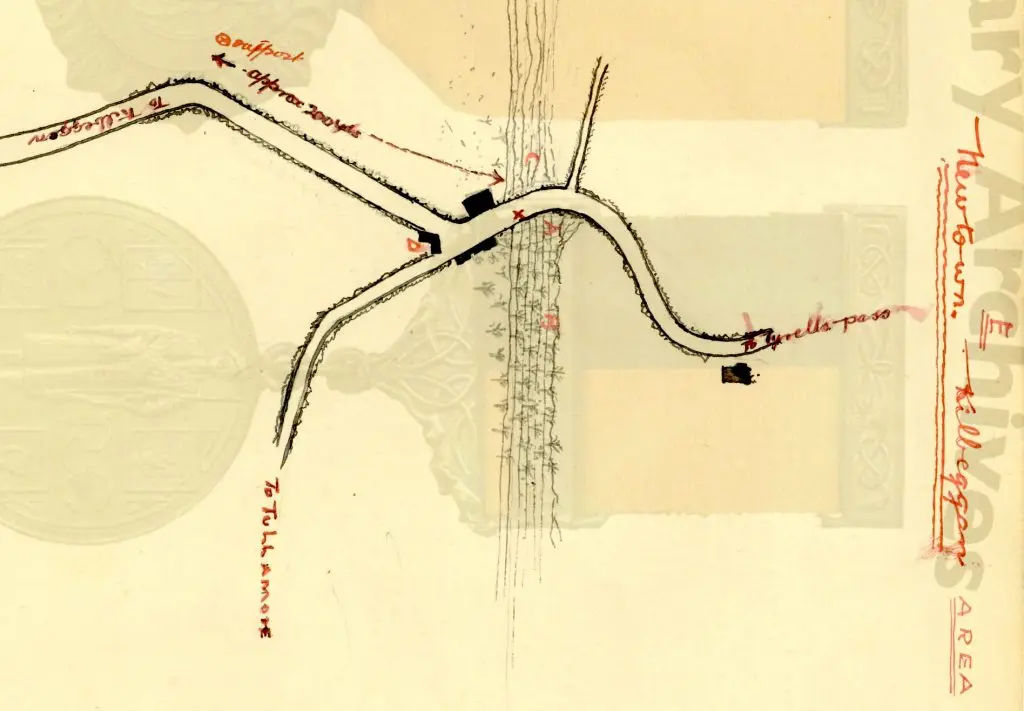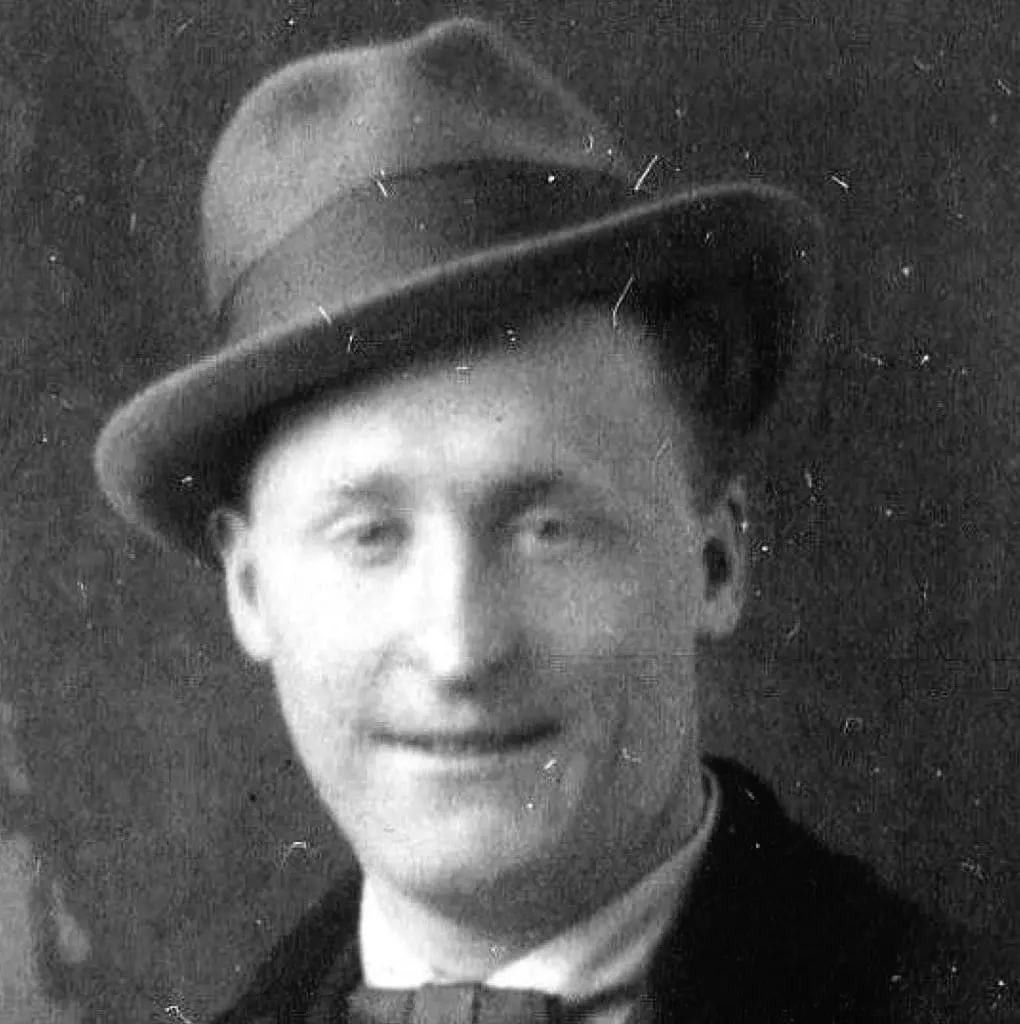

Historians might have looked at IRA activity in Westmeath differently had the conflict produced a significant local engagement between republicans and Crown forces similar to those which occurred at Kilmichael (Cork, November 1920) or Clonfin (Longford, February 1921).
There were a handful of opportunities for such an ambush in Westmeath, which for various reasons – bad timing, poor weaponry, unfavourable terrain, preparedness on the part of Crown forces, or perhaps even a lack of ruthlessness from the guerrillas – did not achieve such deadly results. A March 1921 ambush of a convoy of Black and Tans and police at Newtown Cross, on the Kilbeggan side of Tyrrellspass, was one such example of an action which could have ended much differently.
Russell Shortt, in his study of the Irish War of Independence in Westmeath, identified Kilbeggan as one of the most difficult areas for the Royal Irish Constabulary to police during the period. Shortt counted sixty-six indictable offences in the area centred on Kilbeggan – two more than that of Mullingar. In terms of direct attacks on the police, Shortt highlights the IRA in the Kilbeggan and Athlone areas as outliers, with thirteen and twelve attacks respectively. In Kilbeggan, the IRA engaged the police as many times as their comrades in Mullingar, Castlepollard, Kinnegad and Delvin combined.
That Kilbeggan was ‘the most radical area of resistance’ during the conflict, Shortt argues, was down to a ‘strong tradition of resistance’ locally, the initial influence of IRA organiser Ernie O’Malley (who operated in the area in early 1918), and the willingness of the Kilbeggan Company to heed orders from the IRA’s general headquarters (GHQ). As Marie Coleman argues in her study of Longford, charismatic local leadership also cannot be discounted as a factor in areas of more pronounced activity. In Kilbeggan, the McGuinness brothers, sons of a local schoolteacher, were at the thick of IRA activity well beyond the boundaries of their town and deep into north Offaly. Sean McGuinness was the ranking officer in 1 Battalion, 1 Offaly Brigade, under whose remit the Kilbeggan area fell; throughout the guerrilla war, he showed initiative, an ability to avoid arrest and a willingness to openly confront Crown forces in the field. His brother, Frank, was second-in-command of the over seventy-strong Kilbeggan Company, where Patrick Guilfoyle (OC) and his brothers, Joseph and James, were also among the most active guerrillas in the district.
Prior to March 1921, much of the IRA activity against Crown forces in Kilbeggan involved holding up individual policemen and relieving them of their weapons or bicycles. One such attempt at Cloneyglen on 3 August 1920 resulted in an exchange of fire with a police patrol. Between then and the early weeks of 1921, the Kilbeggan Company lay in wait for various ambush opportunities, without much success.
One opportunity finally presented itself on the morning of Thursday, 3 March 1921, when a truckload of Black and Tans left Kilbeggan via the Dublin Road to appear before Lord Justice Ronan at a sitting of the Westmeath Assizes in Mullingar. They were followed not far behind by a private car carrying RIC officers, including the district inspector for Kilbeggan, Victor D. Corbett.
Recollections of IRA members compiled in support of military service pension applications put the strength of this Black and Tan detail at fifteen men in one tender. The IRA force, meanwhile, numbered just over thirty men drawn from the Kilbeggan and Durrow Companies, 1 Battalion, 1 Offaly Brigade, with a select few involved in the exchange of fire.
The Tans had just entered the staggered crossroads at Newtown when they encountered a trench and obstruction on the road. The IRA was divided into two sections on either side of the road – an outpost to the northwest (on the Kilbeggan side), and another party to the southeast (on the Tyrrellspass side), who opened fire with with rifles and shotguns when the lorry reached the trench.
The shooting continued for about ten minutes, with the Tans forced to scatter and find makeshift cover from which to return fire. Although police reports at the time suggested that there were no casualties, the IRA claimed that one of the Tans appeared to have been wounded, having fallen out of the lorry. They also believed that the entire Black and Tan detail was poised to surrender, until District Inspector Corbett and two of his RIC colleagues arrived on the scene.
District Inspector Corbett was, like all the men firing at his convoy from the roadside of Newtown, an Irishman and a Catholic. Victor Daniel Corbett was born in Sligo town on 23 May 1895, the son of Edward, a dental surgeon from Stephen Street, and Mary Corbett (née Fogarty). The family moved to Exeter, England, where Victor trained as an army officer and studied medicine. On the outbreak of the First World War, he went to France as a lieutenant with the Middlesex Regiment. By the end of the war, he had risen the rank of acting major.
Wounded during the German Spring Offensive in May 1918, Corbett was awarded a Croix de Guerre with a silver star by the French government for gallantry in combat, and was mentioned in dispatches by the commander-in-chief of the British Expeditionary Forces, Field Marshal Sir Douglas Haig.
After the war, he reverted to civilian life and joined the Royal Irish Constabulary. On 17 August 1920, at the age of just twenty-five, he was appointed district inspector for the Kilbeggan area, succeeding David Windrum Carlisle.
At Newtown, Corbett’s experience under fire was a game-changer, and he turned a potential IRA victory on its head following his arrival at the scene. Digging in behind ditches at an old school building near the crossroads, Corbett and his fellow police officers concentrated intense machine gun and rifle fire on the IRA’s attacking party, eventually forcing them to withdraw.
The March 1921 report by the RIC county inspector for Westmeath stated that the ambush ‘miscarried as the leading car was not brought to a standstill by the trench previously cut, & a party under D.I. Corbett in a Ford car were able to open fire unexpectedly & so put the ambushers to flight’. The IRA placed the blame squarely on its outpost on the Kilbeggan side, arguing that they ‘had no right to let... [Corbett’s] car come into the line of fire... by doing so the [IRA] attackers were caught unaware and had not much chance of holding their positions’.
‘Nothing [was] gained nor lost’ as a result of the action, IRA veterans recalled, though they insisted that ‘some of the Tans’ were wounded after the initial fusillade. The RIC claimed that there were no police casualties, and while some of the retreating rebels were ‘seen to fall’, the police accepted that they may have merely ‘tripped over the uneven ground’ during their hasty retreat. The Westmeath Examiner of the time cited unconfirmed reports that two of the ambush party were wounded, and that ‘50 or 60 shots were exchanged before the encounter ended’.
The Kilbeggan and Durrow men credited with involvement in the assault at Newtown or associated outpost duties were: Sean McGuinness, James McGuinness, Joseph Guilfoyle, Willie Killoran, Patrick Fogarty, John Crowley, Owen Daly, Patrick Crowley, Christopher Bastick, Patrick Bohan, Willie Matthews, Patrick Troy, Bernard Bracken, Daniel Keyes, Joseph Neville, Patrick Egan, James Whelan, Michael Garry, Michael McDermott, John Doody, James O’Neill, Joseph Pidgeon, Patrick Gorman, Terry Pidgeon, Thomas Pidgeon, William Shaughnessy, John Fox, John Quinn, Patrick O’Reilly, Thomas Finlay, Michael Brophil, Daniel Ravenhill, James McDermott.
On the ambush: Westmeath Examiner, 5 March 1921; RIC county inspector monthly report for Westmeath, March 1921 (‘British in Ireland’ series, CO 904/114, Maynooth University); brigade activity reports (file A/17) and 1 Battalion membership rolls (file RO/173) for 1 Offaly Brigade IRA (Military Service Pensions Collection, Irish Military Archives); Russell Shortt, ‘IRA activity in Westmeath during the War of Independence, 1918-21’ (M.A. thesis, Maynooth University, 2001); Marie Coleman, County Longford and the Irish Revolution (Dublin, 2003).
On Corbett: Civil birth records for Sligo district, 1895 (IrishGenealogy.ie); Western Morning News (Plymouth), 28 May 1917; obituary in the Wicklow People, 30 March 1973.
Content Last Updated/Reviewed: 31/03/2021